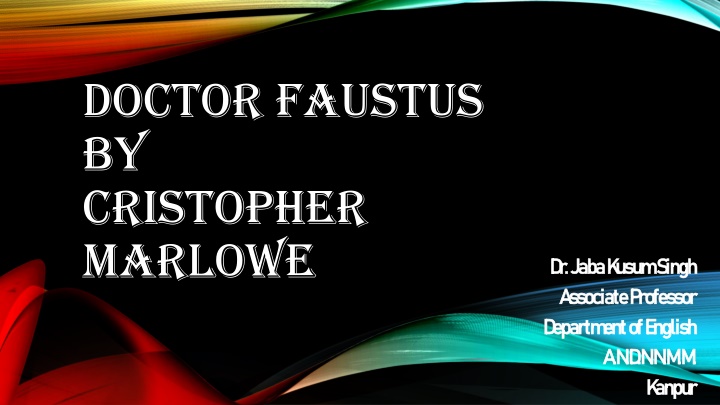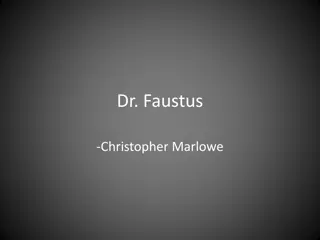
Christopher Marlowe: The Renaissance Dramatist and Poet
Explore the life and works of Christopher Marlowe, a prominent figure in English Renaissance literature. Learn about his early career at Cambridge, his famous plays like "Doctor Faustus," and his contribution to the development of British theatre. Discover Marlowe's unique dramatic art and poetic style that set him apart as a revolutionary figure of his time.
Download Presentation

Please find below an Image/Link to download the presentation.
The content on the website is provided AS IS for your information and personal use only. It may not be sold, licensed, or shared on other websites without obtaining consent from the author. If you encounter any issues during the download, it is possible that the publisher has removed the file from their server.
You are allowed to download the files provided on this website for personal or commercial use, subject to the condition that they are used lawfully. All files are the property of their respective owners.
The content on the website is provided AS IS for your information and personal use only. It may not be sold, licensed, or shared on other websites without obtaining consent from the author.
E N D
Presentation Transcript
DOCTOR FAUSTUS BY CRISTOPHER MARLOWE D r. D r.Jaba JabaK usum Singh K usum Singh A ssociate P rofessor A ssociate P rofessor D epartm ent of E nglish D epartm ent of E nglish A .N .D .N .N .M .M . A .N .D .N .N .M .M . K anpur K anpur
CRISTOPHER MARLOWE : THE DRAMATIST Born: Feb.6,1564 at Canterbury Father Marlowe was a prosperous Shoemaker and a Clarke too Marlowe was a post graduate from Cambridge University, Corpus Christi College. He was one among the band of university scholars who came to London, towards the end of the 16thcentury, and are known as The University Wits. He had special interest in classical poetry and legends. Ovid and Virgil were his favourite classical poets.
At Cambridge, he started his literary career with translations. His first play, Dido, Queen of Carthage (1586-87). Second play, Tamburlaine- The Great . His first great play that made him famous among his contemporary dramatists. The next play The Tragical History of Doctor Faustus (1588). The Jew of Malta (1590) Edward the Second (1590) The Massacre of Paris (1593) Before his death he started a poem, A love Story of Hero and Leander but he couldn t complete it. Later on George Chapman completed the same.
DEVELOPMENT OF BRITISH THEATRE DURING MARLOWE S TIME The fully developed British drama was followed as a sequel to Mystery, Miracle, Morality and Interlude. All these forms were performed either in churches or in different towns. The morality and miracle plays were theme based plays based upon the legends on the biblical saints. Interlude was a type of one act play. By the middle of 16th century, dramatic pieces came into being. The first full length play in English (1553) Ralph Roister Doister by Nicolas Udall.(this was however a comedy)
1561 -62 The tragedy of Gorboduc the first full length British Tragic play written by Thomas Sackville and Thomas Norton. With the growth of public playhouses in London, drama became a popular source of entertainment. The University Wits (John Lyly, George Peele, Thomas Kate and Christopher Marlo) established Drama and introduced it as a national art form. They set the fashion for revenge plays on the model of Seneca. Marlow, the chief and the most important playwright of the band was a typical product of English Renaissance.
MARLOWES DRAMATIC ART Study of Marlowe s plays yields very interesting material showing the progression of his poetic art in successive plays. He was more of a poet. He was a revolutionist. He created a new type of dramatic poetry. He delights in the extreme of emotions. He love to deal with fire and thunder. He wanted to present the superman to his audience. Thus, he uses splendid and highly emotional words. His heroes have a hallow round them. Their actions are breath taking aptly the verse that describes them.
CENTRAL THEME OF THE PLAY The theme of this play was very popular during the medieval periods. It is a story of a human being entering into a contract with the Devil for the gratification of his desires and in exchange agreeing to give away his soul. It is also believed by some scholars that one Doctor Faustus was a really living in Germany. The full story of Doctor Faustus, the magician was published in Germany in 1587 known as Faustbuch . This crude story of Doctor Faustus, the magician who met a ghastly end was completely changed and transmuted by Marlowe into a work of art. Doctor Faustus of the legend and of Marlowe belongs to two different worlds.
The hero of the play is a typical renaissance man. He has all the elemental vitality of his time. He is a passionate man with indomitable feelings. He is shown as a human being with a souring ambition, unusual vigour. In his pursuance of far off goals, he is left alone in the end. He is struck down by fate. The versification in the drama is befitting. The language used by the dramatists is a fit vehicle to give expression to the high surcharged passion of the hero s heart.
The play opens with Doctor Faustus studying in his study. He is dissatisfied with his life of scholarship. He has towering ambition. He wants to become superhuman. He wanted to follow the path of necromancy and magic. He conjures up Mephistopheles the chief servant of the arch-fiend, Lucifer. He is no coward. He commands in a total Italian manner, Marlowe is an atheist and so is his protagonist.
Faustus wanted to know all about Lucifers life. Marlowe is at his best in his exact description of the hell. A bargain is struck. Faustus is ready to sell his soul. In return, he may live 24 years in all voluptuousness and Mephistophilis always at his beck and call during these years. Marlowe s description is so wonderful that he spiritualises what he borrows. In the next scene, Marlowe shows Faustus in a mood of repentance. There is a detail description of how Faustus is in a war with good and bad angels.
Lucifer arrives and talks of seven deadly sins. Faustus is back to his spirit. The drama has characters like Wagner, servant of Faustus and two Latin scholars and a clown. The Burlusque provided in the drama although is crude but provides a comic relief to the audience. The next Phase of Faustus activity takes place in Rome. He demonstrates some magic infront of the Pope. The play in each scene moves from one place to another. In the midst of the show of Faustus magical power, although acts as a dramatic relief but time and again Faustus remembers that his doom is approaching.
The fifth and the last act of the play depicts Faustus end. The most moving portion of the play. Faustus is in Wittenberg with his scholar friends. Marlowe is at his best when he describes Faustus conjuring up the apparition of Helen of Troy. The apparition passes over the stage. It is unbelievable for all the spectators. Faustus himself cannot sit as a passive spectator. Her orders Mephistophilis to bring Helen once again as Helen appears the dialogue of Faustus is the best ever line written by any English Dramatist. Was this the face that longed a thousand ships, And burned the topless towers of Ilium?
Marlowe made and sketched Helen as a symbol of all that was charming, magnificent in the ancient world. She brings with her all the memories of Homer s poetry She finally becomes a heavenly creature. Although Faustus is a dark and sinister character but in Marlowe s hand we find that he has deep human element. Faustus s repentance is highlighted to make him an ideal tragic Hero. Marlowe follows the source material yet he transforms everything through the medium of his powerful verse. At last, when Faustus asks all his friends to leave the room and he remains alone for the terrible destiny he arouses pity and fear.
THANK YOU!! That s all folks





















